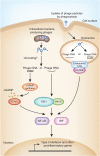Resident viruses and their interactions with the immune system
- PMID: 23778792
- PMCID: PMC3760236
- DOI: 10.1038/ni.2614
Resident viruses and their interactions with the immune system
Abstract
The human body is colonized with a diverse resident microflora that includes viruses. Recent studies of metagenomes have begun to characterize the composition of the human 'virobiota' and its associated genes (the 'virome'), and have fostered the emerging field of host-virobiota interactions. In this Perspective, we explore how resident viruses interact with the immune system. We review recent findings that highlight the role of the immune system in shaping the composition of the virobiota and consider how resident viruses may impact host immunity. Finally, we discuss the implications of virobiota-immune system interactions for human health.
Conflict of interest statement
The authors declare no competing financial interests.
Figures



References
Publication types
MeSH terms
Grants and funding
LinkOut - more resources
Full Text Sources
Other Literature Sources

